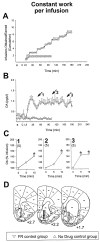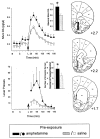Sensitization of midbrain dopamine neuron reactivity promotes the pursuit of amphetamine
- PMID: 12040071
- PMCID: PMC6758806
- DOI: 10.1523/JNEUROSCI.22-11-04654.2002
Sensitization of midbrain dopamine neuron reactivity promotes the pursuit of amphetamine
Abstract
Stimulant drugs such as amphetamine are readily self-administered by humans and laboratory animals by virtue of their actions on dopamine (DA) neurons of the midbrain. Repeated exposure to this drug systemically or exclusively in the cell body region of these neurons in the ventral tegmental area (VTA) leads to long-lasting changes in dopaminergic function that can be assessed by increased locomotor activity and enhanced DA overflow in the nucleus accumbens (NAcc) after re-exposure to the drug. Three experiments were conducted to evaluate the possibility that this enduring sensitized reactivity underlies compulsive drug self-administration. In all experiments, rats were pre-exposed to amphetamine and, starting 10 d later, their intravenous self-administration of the drug was assessed. In the first experiment, rats previously exposed to amphetamine systemically or exclusively in the VTA subsequently worked harder than untreated animals to obtain the drug when the work required to obtain successive infusions was increased progressively. In the second experiment, this progressively increasing workload was found to decrease the magnitude of amphetamine-induced DA overflow observed with successive infusions until responding ceased. Rats previously exposed to amphetamine were more resistant to this decline and more apt to maintain responding. Finally, in experiment three, a noncontingent priming injection of the drug produced a greater NAcc DA response and a greater parallel increase in lever pressing in drug compared with saline pre-exposed rats. Together, these results demonstrate a direct relation between drug-induced sensitization of midbrain dopamine neuron reactivity and the excessive pursuit and self-administration of an abused substance.
Figures




References
-
- Bjijou Y, Stinus L, Le Moal M, Cador M. Evidence for selective involvement of dopamine D1 receptors of the ventral tegmental area in the behavioral sensitization induced by intra-ventral tegmental area injections of d-amphetamine. J Pharmacol Exp Ther. 1996;277:1177–1187. - PubMed
-
- Bradberry CW, Gruen RJ, Berridge CW, Roth RH. Individual differences in behavioral measures: correlations with nucleus accumbens dopamine measured by microdialysis. Pharmacol Biochem Behav. 1991;39:887–892. - PubMed
-
- Browman KE, Kantor L, Richardson S, Badiani A, Robinson TE, Gnegy ME. Injection of the protein kinase C inhibitor Ro31–8220 into the nucleus accumbens attenuates the acute response to amphetamine: tissue and behavioral studies. Brain Res. 1998;814:112–119. - PubMed
-
- Cador M, Bjijou Y, Stinus L. Evidence of a complete independence of the neurobiological substrates for the induction and expression of behavioral sensitization to amphetamine. Neuroscience. 1995;65:385–395. - PubMed
-
- Crombag HS, Mueller H, Browman KE, Badiani A, Robinson TE. A comparison of two behavioral measures of psychomotor activation following intravenous amphetamine or cocaine: dose- and sensitization-dependent changes. Behav Pharmacol. 1999;10:205–213. - PubMed
Publication types
MeSH terms
Substances
Grants and funding
LinkOut - more resources
Full Text Sources
